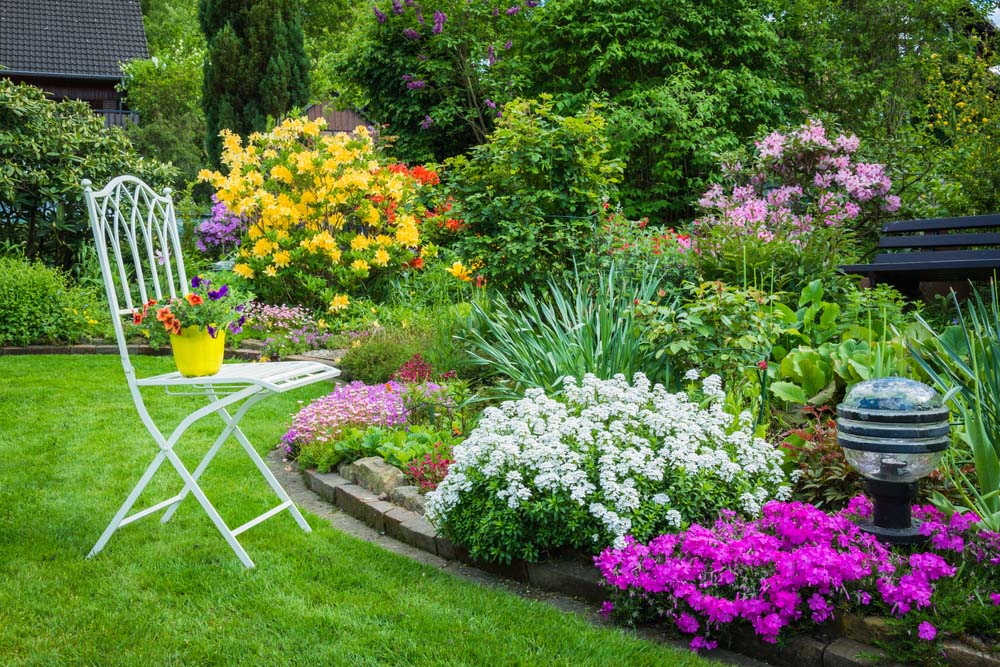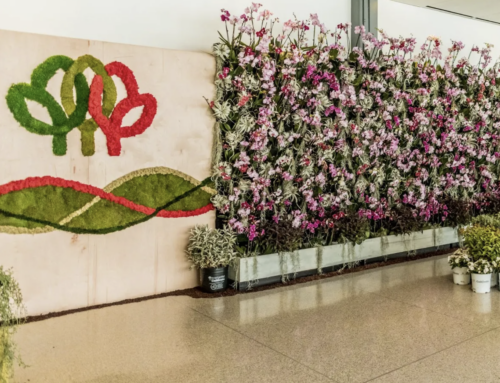Years ago, I recall my boss looking at my office with a discouraging expression. I knew what might seem like a mess to a layperson, was really an indication that I had a lot going on, a visible sign of my efforts in action and progress in motion. My boss didn’t see it that way and said to me, “A cluttered office is a sign of a cluttered mind.” With that insight, there may well be similarities in the way gardeners organize their plants in the home gardens.
Consider taking a stroll by homes in a neighborhood and view the front yard and gardens. I favor the older neighborhoods, smaller houses, and yards located close to the sidewalk and street. The walk can be refreshing, enlightening, and even entertaining to observe the layout and design of the flower gardens out front, surrounding the porch and entrance sidewalk.
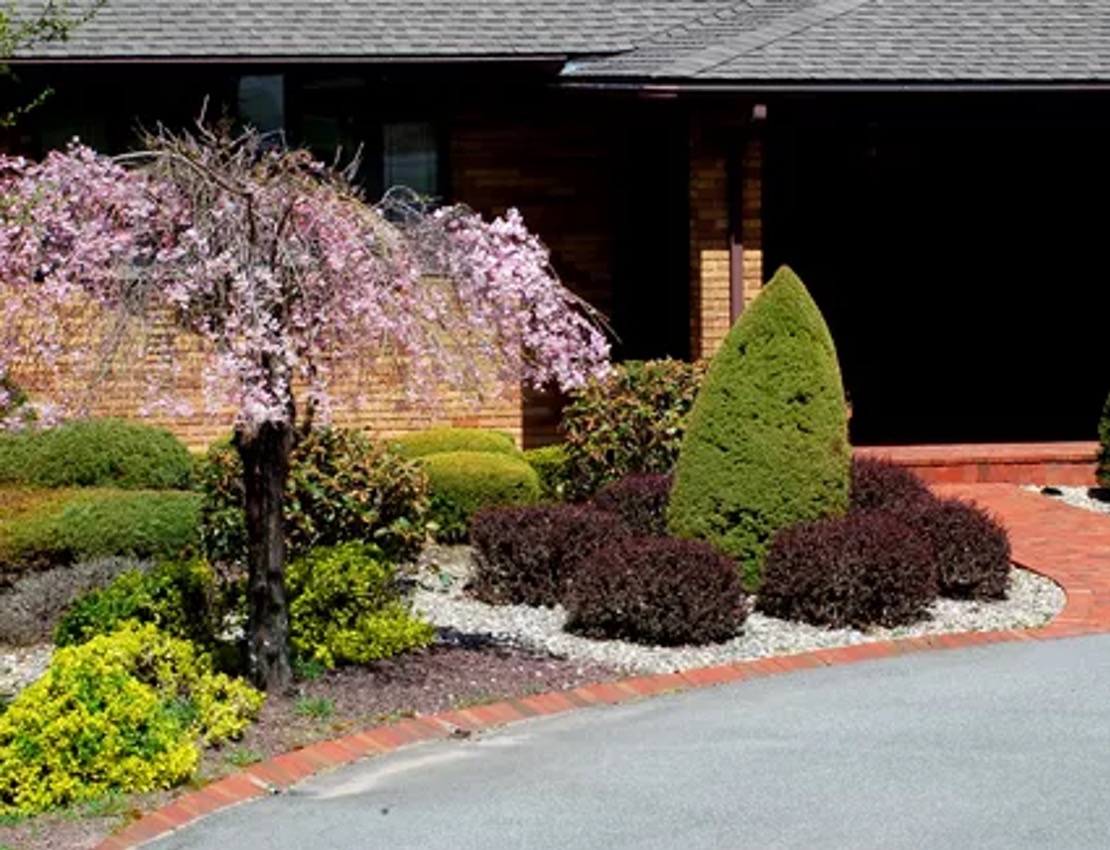
What about the home with the front yard garden of perfectly spaced plantings?
Note the marigolds and begonias in evenly spaced rows, and the zinnias, snapdragons, and geraniums all carefully aligned by height, with the shortest ones in front, and the taller ones gradually ascending to the back. The birdbath, at the geometric center of the garden, is void of bird excrement, paint color matching both the petunias encircling the base, as well as the house shutters. The sharply edged entrance sidewalk reaches the front porch step where six boxwood shrubs; three to a side are sheared in precise 2.5’ x 2.5’ squares. It would be presumptuous to assume it is home to a CPA or an engineer who is admired for his or her accuracy and careful methodic approach to life, but it might be a safe guess.
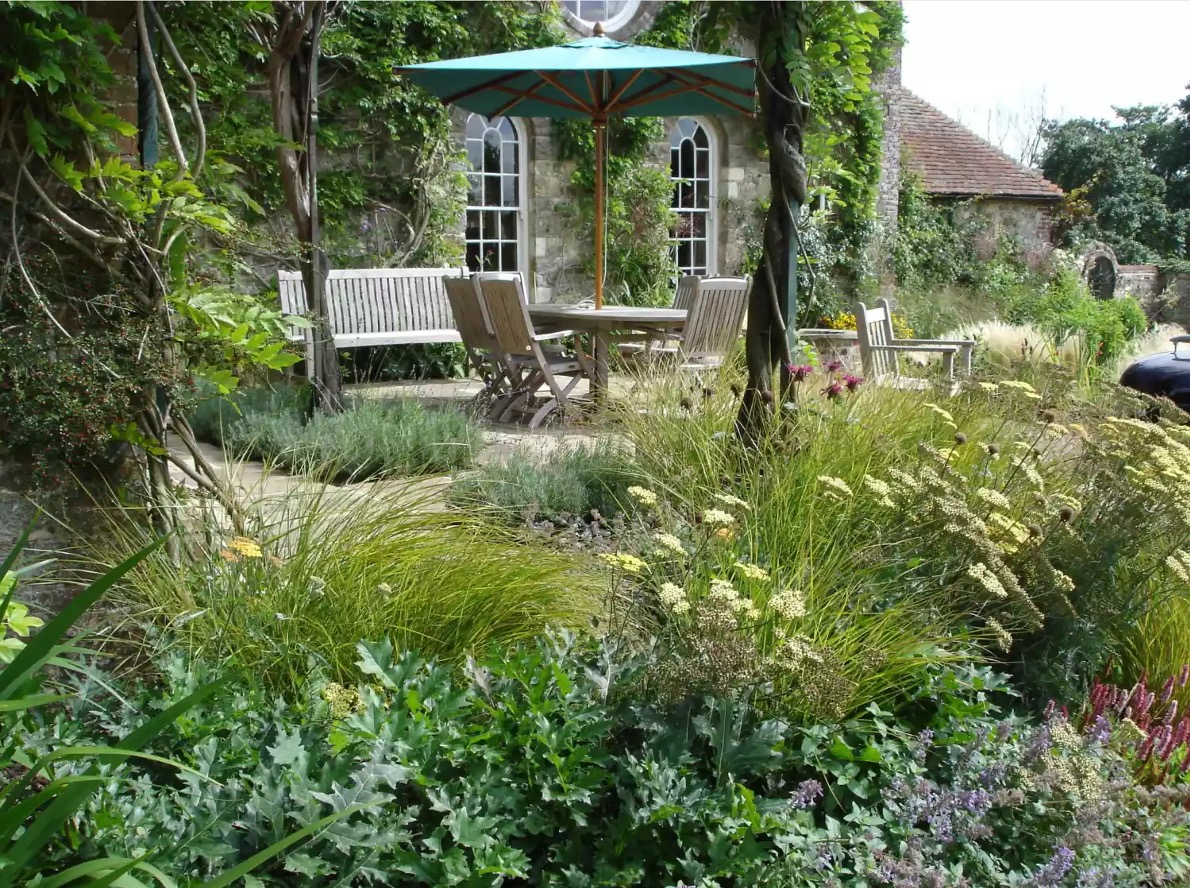
In that light, does an unconventional front yard flower garden, jam-packed with an assortment of plant species, textures, varying sizes, colors, and scents randomly scattered about with a featured focal point of carefully stacked trio of rocks imply the garden designer is scattered, disheveled or has a cluttered mind? I might personally take issue with that. Besides, the sign “Eden Revisited” gives it a biblical exception.
Regardless of your garden style, the concern can arise on how close we place our plants and are there benefits or disadvantages to either way.
A wise first approach is to know the mature size of the plant species you are installing. Too often, plants are installed roughly based on their appearance at planting time, which can be anywhere from 5% to 95% of its eventual size. For example, the 6” Hollyhock plants installed in spring can eventually reach 8’ or the early spring. The purchase of globe-shaped Catmint roughly 5” in diameter can expand to almost 2’ height and a 3’ spread. Knowing there are many environmental factors influencing growth, it is difficult to determine their eventual size when the growth finally stops.
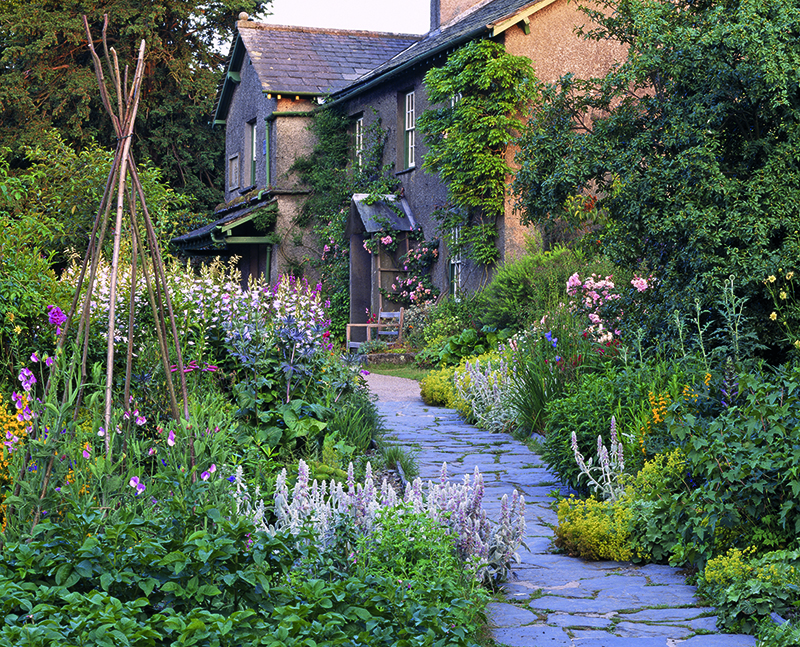
Herbaceous borders along the path leading to the front porch at Hill Top Farm of Beatrix Potter fame. A `wigwam’ for sweet peas is prominent.
How much room should there be between plants when finally grown?
No social distancing here, I have no problem in having them touch or align or at times slam against one another.
Advantages of having a full garden of plants with little room to spare? –
- Weed Control – When there is no exposed soil in the garden, when flowers and foliage fill up all available space there are far fewer weeds to contend with. Research shows that most weed seeds require direct contact with soil and need sunlight to germinate and grow. With a full garden of plants, sunlight is prevented from striking the soil surface and most weeds are shut out. This results in less labor in weeding and eliminating pre-emergent weed controls if used.
- Retention of Soil Moisture – Soil not covered with plants or mulch dries out sooner, especially if exposed to sunlight. Sandy soil obviously loses water quickly and with the surface bare to the sun, clay soil becomes hard, compacted, and somewhat baked. None of these scenarios are good for your garden. A tightly packed garden of plants shading the soiled surface is far better at retaining moisture, essential to growth and plant health. Less supplemental water is required in times of drought or high temperatures. The difference between ambient air temperature and the soil beneath a healthy canopy of foliage can be 8 degrees cooler.
- Potential Plant Loss is Not as Evident – Inevitably, plants can be lost from digging by a squirrel, a rabbit chow-down, the neighbor’s wildly shot basketball, and other hazards. Open gaps are usually not as large, and over-lapping foliage of adjacent plants is likely to help cover the loss. When damage occurs to a row of plants perfectly aligned, unless you have back-up plants identical in appearance secretly stashed just waiting to make an appearance, you are bound to have an eye-sore.
- Overall Impact and Appearance! – A full bed of plants, amassed with flowers looks better! Many of the classic “Cottage Garden” designs are an excellent illustration of the benefits of a jam-packed array of flowers.
Disadvantages of a plant-packed garden –
- Disease Prevalence – Considering the weather, seasonal conditions, and what area of the country you might live, when foliage is tight with other foliage, air circulation between plants is minimized and leaves can be predisposed to disease conditions. When this is the case, especially when humidity is high, it is best to reduce supplemental (irrigation) and limit the spread of disease. Remember, when the foliage is denser, soil moisture loss is minimized and supplemental water is not needed, or should at least be limited.
- Plant Access – The ability to enter and access areas of the garden can be a challenge to avoid squashing plants. That is why small, not readily seen, access pathways are created that allow careful walking to retrieve a Frisbee or pull a weed. Stepstones strategically placed is another way to allow informal entry when needed to avoid damaging the tightly grown plants.
By now, you may have a preference that fits your garden style and plan. Hopefully, this background on technical issues and the result from choosing “the orderly” versus “the free-style” approach will reinforce your decision.
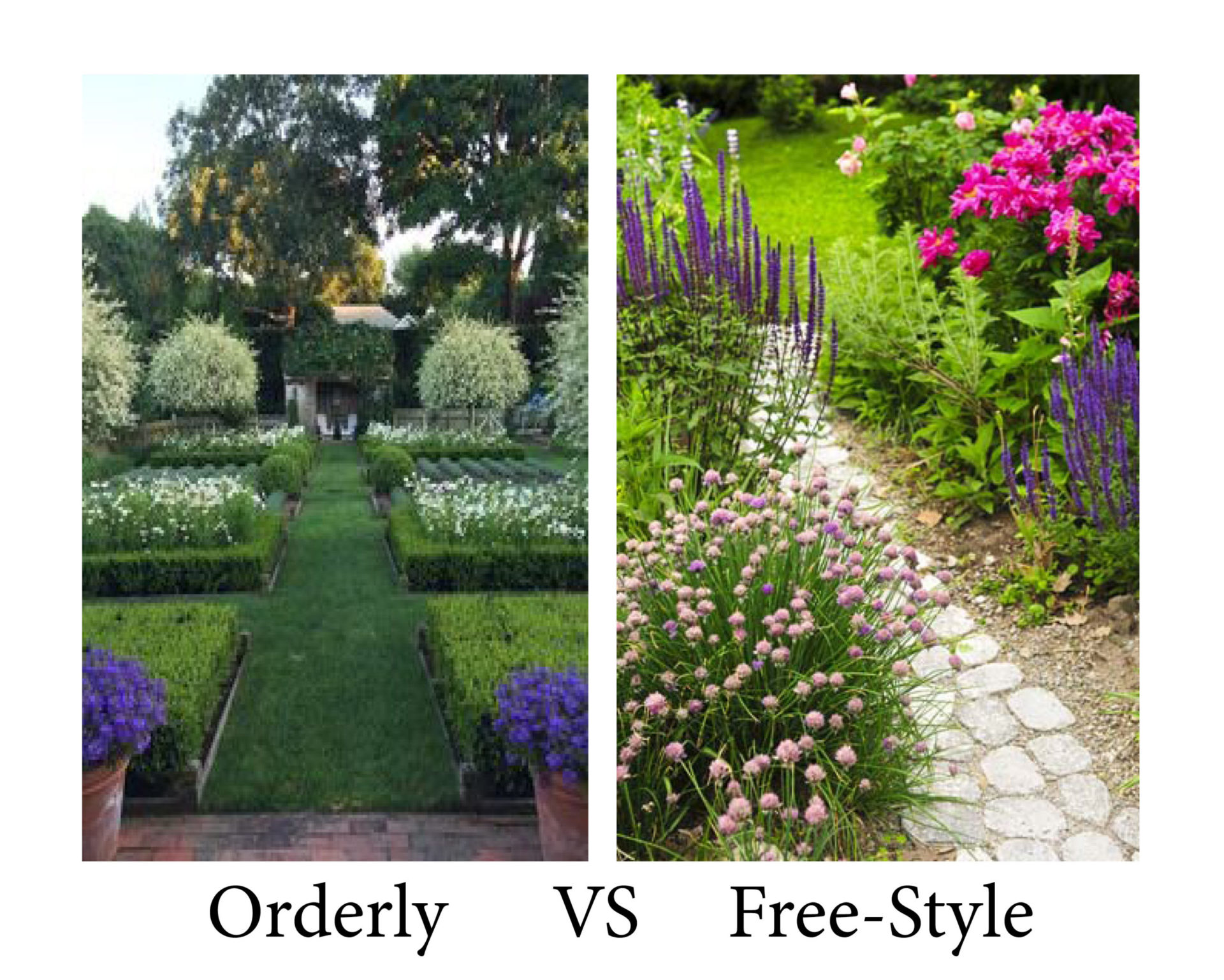
-Rob McCartney, Horticulturist
Please feel free to contact me with any questions or for more info at:
Connect with us on social media!
Years ago, I recall my boss looking at my office with a discouraging expression. I knew what might seem like a mess to a layperson, was really an indication that I had a lot going on, a visible sign of my efforts in action and progress in motion. My boss didn’t see it that way and said to me, “A cluttered office is a sign of a cluttered mind.” With that insight, there may well be similarities in the way gardeners organize their plants in the home gardens.
Consider taking a stroll by homes in a neighborhood and view the front yard and gardens. I favor the older neighborhoods, smaller houses, and yards located close to the sidewalk and street. The walk can be refreshing, enlightening, and even entertaining to observe the layout and design of the flower gardens out front, surrounding the porch and entrance sidewalk.

What about the home with the front yard garden of perfectly spaced plantings?
Note the marigolds and begonias in evenly spaced rows, and the zinnias, snapdragons, and geraniums all carefully aligned by height, with the shortest ones in front, and the taller ones gradually ascending to the back. The birdbath, at the geometric center of the garden, is void of bird excrement, paint color matching both the petunias encircling the base, as well as the house shutters. The sharply edged entrance sidewalk reaches the front porch step where six boxwood shrubs; three to a side are sheared in precise 2.5’ x 2.5’ squares. It would be presumptuous to assume it is home to a CPA or an engineer who is admired for his or her accuracy and careful methodic approach to life, but it might be a safe guess.

In that light, does an unconventional front yard flower garden, jam-packed with an assortment of plant species, textures, varying sizes, colors, and scents randomly scattered about with a featured focal point of carefully stacked trio of rocks imply the garden designer is scattered, disheveled or has a cluttered mind? I might personally take issue with that. Besides, the sign “Eden Revisited” gives it a biblical exception.
Regardless of your garden style, the concern can arise on how close we place our plants and are there benefits or disadvantages to either way.
A wise first approach is to know the mature size of the plant species you are installing. Too often, plants are installed roughly based on their appearance at planting time, which can be anywhere from 5% to 95% of its eventual size. For example, the 6” Hollyhock plants installed in spring can eventually reach 8’ or the early spring. The purchase of globe-shaped Catmint roughly 5” in diameter can expand to almost 2’ height and a 3’ spread. Knowing there are many environmental factors influencing growth, it is difficult to determine their eventual size when the growth finally stops.

Herbaceous borders along the path leading to the front porch at Hill Top Farm of Beatrix Potter fame. A `wigwam’ for sweet peas is prominent.
How much room should there be between plants when finally grown?
No social distancing here, I have no problem in having them touch or align or at times slam against one another.
Advantages of having a full garden of plants with little room to spare? –
- Weed Control – When there is no exposed soil in the garden, when flowers and foliage fill up all available space there are far fewer weeds to contend with. Research shows that most weed seeds require direct contact with soil and need sunlight to germinate and grow. With a full garden of plants, sunlight is prevented from striking the soil surface and most weeds are shut out. This results in less labor in weeding and eliminating pre-emergent weed controls if used.
- Retention of Soil Moisture – Soil not covered with plants or mulch dries out sooner, especially if exposed to sunlight. Sandy soil obviously loses water quickly and with the surface bare to the sun, clay soil becomes hard, compacted, and somewhat baked. None of these scenarios are good for your garden. A tightly packed garden of plants shading the soiled surface is far better at retaining moisture, essential to growth and plant health. Less supplemental water is required in times of drought or high temperatures. The difference between ambient air temperature and the soil beneath a healthy canopy of foliage can be 8 degrees cooler.
- Potential Plant Loss is Not as Evident – Inevitably, plants can be lost from digging by a squirrel, a rabbit chow-down, the neighbor’s wildly shot basketball, and other hazards. Open gaps are usually not as large, and over-lapping foliage of adjacent plants is likely to help cover the loss. When damage occurs to a row of plants perfectly aligned, unless you have back-up plants identical in appearance secretly stashed just waiting to make an appearance, you are bound to have an eye-sore.
- Overall Impact and Appearance! – A full bed of plants, amassed with flowers looks better! Many of the classic “Cottage Garden” designs are an excellent illustration of the benefits of a jam-packed array of flowers.
Disadvantages of a plant-packed garden –
- Disease Prevalence – Considering the weather, seasonal conditions, and what area of the country you might live, when foliage is tight with other foliage, air circulation between plants is minimized and leaves can be predisposed to disease conditions. When this is the case, especially when humidity is high, it is best to reduce supplemental (irrigation) and limit the spread of disease. Remember, when the foliage is denser, soil moisture loss is minimized and supplemental water is not needed, or should at least be limited.
- Plant Access – The ability to enter and access areas of the garden can be a challenge to avoid squashing plants. That is why small, not readily seen, access pathways are created that allow careful walking to retrieve a Frisbee or pull a weed. Stepstones strategically placed is another way to allow informal entry when needed to avoid damaging the tightly grown plants.
By now, you may have a preference that fits your garden style and plan. Hopefully, this background on technical issues and the result from choosing “the orderly” versus “the free-style” approach will reinforce your decision.

-Rob McCartney, Horticulturist
Please feel free to contact me with any questions or for more info at:
Connect with us on social media!

